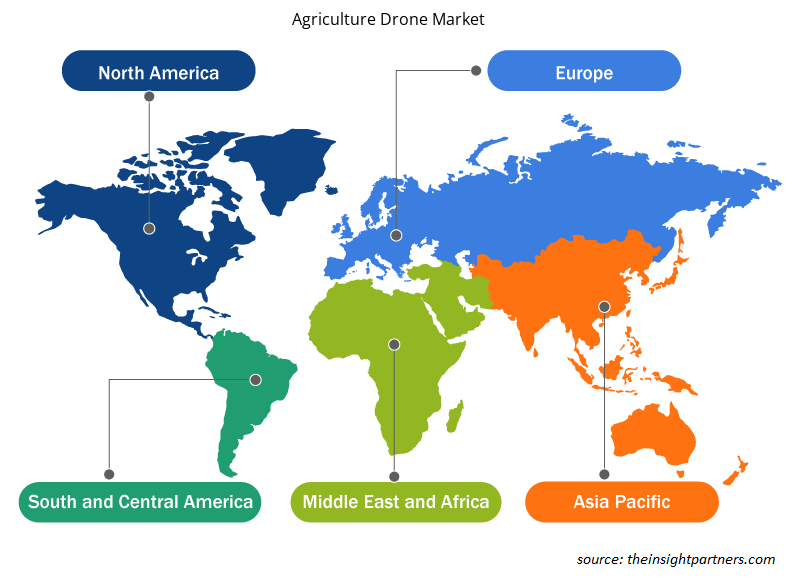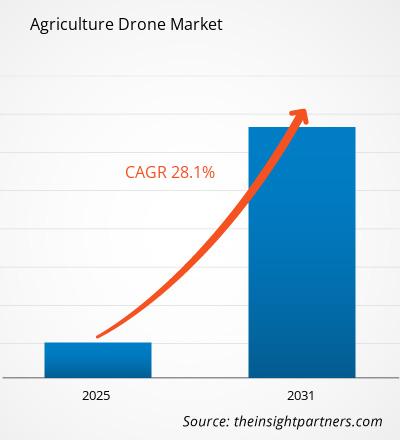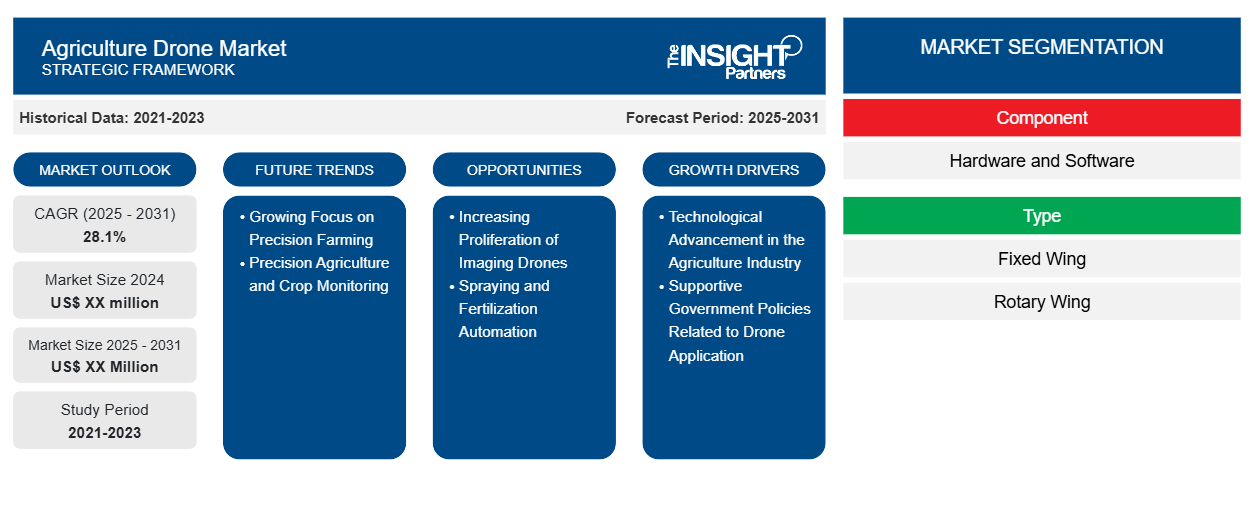من المتوقع أن يسجل سوق الطائرات بدون طيار الزراعية معدل نمو سنوي مركب بنسبة 28.1٪ من عام 2023 إلى عام 2031، مع توسع حجم السوق من XX مليون دولار أمريكي في عام 2023 إلى XX مليون دولار أمريكي بحلول عام 2031.
تم تقسيم التقرير حسب المكون (الأجهزة والبرامج)، والنوع (الجناح الثابت والجناح الدوار)، وموقع المزرعة (داخلي وخارجي)، ونوع المنتج (المحاصيل الحقلية، والفواكه والخضروات، ومنتجات الألبان والثروة الحيوانية، وغيرها)، وحجم المزرعة (المحاصيل الصغيرة والمتوسطة، والمحاصيل الكبيرة)، والتطبيق (الزراعة الدقيقة، ومراقبة الثروة الحيوانية، والدفيئات الذكية، وغيرها). تم تقسيم التحليل العالمي بشكل أكبر على المستوى الإقليمي والدول الرئيسية. يقدم التقرير القيمة بالدولار الأمريكي للتحليل والقطاعات المذكورة أعلاه.
غرض التقرير
يهدف تقرير سوق الطائرات بدون طيار الزراعية الصادر عن The Insight Partners إلى وصف المشهد الحالي والنمو المستقبلي وأهم العوامل الدافعة والتحديات والفرص. سيوفر هذا رؤى لمختلف أصحاب المصلحة في الأعمال التجارية، مثل:
- مزودي/مصنعي التكنولوجيا: لفهم ديناميكيات السوق المتطورة ومعرفة فرص النمو المحتملة، وتمكينهم من اتخاذ قرارات استراتيجية مستنيرة.
- المستثمرون: إجراء تحليل شامل للاتجاهات فيما يتعلق بمعدل نمو السوق، وتوقعات السوق المالية، والفرص المتاحة عبر سلسلة القيمة.
- الهيئات التنظيمية: لتنظيم السياسات ومراقبة الأنشطة في السوق بهدف تقليل الانتهاكات والحفاظ على ثقة المستثمرين ودعم سلامة السوق واستقرارها.
تجزئة سوق الطائرات بدون طيار الزراعية
عنصر
- الأجهزة والبرامج
يكتب
- جناح ثابت
- الجناح الدوار
موقع المزرعة
- داخلي
- في الهواء الطلق
نوع المنتج
- المحاصيل الحقلية
- الفواكه والخضروات
- الألبان والثروة الحيوانية
- آحرون
نوع المنتج
- المحاصيل الحقلية
- الفواكه والخضروات
- الألبان والثروة الحيوانية
- آحرون
قم بتخصيص هذا التقرير ليناسب متطلباتك
ستحصل على تخصيص لأي تقرير - مجانًا - بما في ذلك أجزاء من هذا التقرير، أو تحليل على مستوى الدولة، وحزمة بيانات Excel، بالإضافة إلى الاستفادة من العروض والخصومات الرائعة للشركات الناشئة والجامعات
-
احصل على أهم اتجاهات السوق الرئيسية لهذا التقرير.ستتضمن هذه العينة المجانية تحليلاً للبيانات، بدءًا من اتجاهات السوق وحتى التقديرات والتوقعات.
محركات نمو سوق الطائرات بدون طيار الزراعية
- التقدم التكنولوجي في صناعة الزراعة: من المتوقع أن يؤدي الانتشار المتزايد للتحول الرقمي وتكامل تطبيقات البرامج لمراقبة الكفاءة التشغيلية الشاملة للأراضي الزراعية إلى دفع نمو سوق الطائرات بدون طيار الزراعية على مستوى العالم.
- السياسات الحكومية الداعمة المتعلقة بتطبيق الطائرات بدون طيار: من المتوقع أن يدعم التركيز الحكومي المتزايد على الزراعة الدقيقة نظرًا لمتطلباتها لتلبية الطلب المتزايد على المنتجات الغذائية في جميع أنحاء العالم نمو سوق الطائرات بدون طيار الزراعية. ومن المتوقع أيضًا أن تعمل السياسات الحكومية الداعمة للطائرات بدون طيار على دفع توسع سوق الطائرات بدون طيار الزراعية خلال الفترة المتوقعة.
الاتجاهات المستقبلية لسوق الطائرات بدون طيار الزراعية
- التركيز المتزايد على الزراعة الدقيقة: تعمل الطائرات بدون طيار الزراعية أيضًا على تعزيز الزراعة الدقيقة من خلال إدارة جدول زمني مناسب للري والحصاد وتسميد الأرض بشكل صحيح. وبالتالي، فإن استخدام التقنيات المتقدمة مثل برامج مراقبة المزارع وتقنيات إدارة المحاصيل وتقنيات التصوير الجوي الرقمي يعمل كعامل محرك رئيسي للسوق.
- الزراعة الدقيقة ومراقبة المحاصيل: تُستخدم الطائرات بدون طيار في الزراعة بشكل متزايد للزراعة الدقيقة، مما يتيح للمزارعين مراقبة صحة المحاصيل وظروف التربة واحتياجات الري في الوقت الفعلي. من خلال الكاميرات وأجهزة الاستشعار عالية الدقة، توفر الطائرات بدون طيار البيانات اللازمة لاتخاذ قرارات مستنيرة، وتحسين الغلة وخفض التكاليف من خلال استهداف مناطق محددة تحتاج إلى الاهتمام.
فرص سوق الطائرات بدون طيار الزراعية
- زيادة انتشار الطائرات بدون طيار: من المتوقع أن توفر إمكانات التصوير الرقمي إلى جانب أجهزة استشعار الطائرات بدون طيار للمزارعين معلومات محتملة عن أراضيهم. علاوة على ذلك، تفرض التغيرات المناخية المفاجئة أيضًا تحديات على قطاع الزراعة، مما يغذي الحاجة إلى حلول ذكية مثل الطائرات بدون طيار الزراعية لتعزيز إنتاجية الشركة وإنتاجية المحاصيل. علاوة على ذلك، يمكن للصور الجوية التي توفرها الزراعة باستخدام الطائرات بدون طيار أن تكشف عن العديد من المخاوف مثل مشاكل الري وتنوع التربة والإصابات الفطرية وتعمل كمجموعة من الإرشادات المستخدمة في الزراعة للتحقيق في المحاصيل لتحديد المضاعفات على الفور.
- أتمتة الرش والتسميد: أصبحت الطائرات بدون طيار ضرورية أيضًا للرش الآلي للمبيدات الحشرية ومبيدات الأعشاب والأسمدة. وتضمن هذه الطائرات بدون طيار المزودة بأنظمة رش متقدمة التوزيع الموحد والحد من النفايات الكيميائية وزيادة الكفاءة التشغيلية. ويسمح هذا الاتجاه للمزارعين بتطبيق المعالجات بدقة أكبر، مما يقلل من التأثير البيئي مع تحسين إنتاجية المحاصيل.
رؤى إقليمية حول سوق الطائرات بدون طيار الزراعية
لقد قام المحللون في Insight Partners بشرح الاتجاهات والعوامل الإقليمية المؤثرة على سوق الطائرات بدون طيار الزراعية طوال فترة التوقعات بشكل شامل. يناقش هذا القسم أيضًا قطاعات سوق الطائرات بدون طيار الزراعية والجغرافيا في جميع أنحاء أمريكا الشمالية وأوروبا ومنطقة آسيا والمحيط الهادئ والشرق الأوسط وأفريقيا وأمريكا الجنوبية والوسطى.

- احصل على البيانات الإقليمية المحددة لسوق الطائرات بدون طيار الزراعية
نطاق تقرير سوق الطائرات بدون طيار الزراعية
| سمة التقرير | تفاصيل |
|---|---|
| حجم السوق في عام 2023 | XX مليون دولار أمريكي |
| حجم السوق بحلول عام 2031 | XX مليون دولار أمريكي |
| معدل النمو السنوي المركب العالمي (2023 - 2031) | 28.1% |
| البيانات التاريخية | 2021-2022 |
| فترة التنبؤ | 2024-2031 |
| القطاعات المغطاة |
حسب المكون
|
| المناطق والدول المغطاة |
أمريكا الشمالية
|
| قادة السوق وملفات تعريف الشركات الرئيسية |
|
كثافة اللاعبين في سوق الطائرات بدون طيار الزراعية: فهم تأثيرها على ديناميكيات الأعمال
يشهد سوق الطائرات بدون طيار الزراعية نموًا سريعًا، مدفوعًا بالطلب المتزايد من المستخدم النهائي بسبب عوامل مثل تفضيلات المستهلكين المتطورة والتقدم التكنولوجي والوعي الأكبر بفوائد المنتج. ومع ارتفاع الطلب، تعمل الشركات على توسيع عروضها والابتكار لتلبية احتياجات المستهلكين والاستفادة من الاتجاهات الناشئة، مما يؤدي إلى زيادة نمو السوق.
تشير كثافة اللاعبين في السوق إلى توزيع الشركات أو المؤسسات العاملة في سوق أو صناعة معينة. وهي تشير إلى عدد المنافسين (اللاعبين في السوق) الموجودين في مساحة سوق معينة نسبة إلى حجمها أو قيمتها السوقية الإجمالية.
الشركات الرئيسية العاملة في سوق الطائرات بدون طيار الزراعية هي:
- شركة ايرو فيرونمنت
- شركة اج ايجل للأنظمة الجوية
- دي جي اي
- نشر الطائرات بدون طيار
- شركة بريسيجن هوك
- شركة ثيرد إليمنت للطيران المحدودة
إخلاء المسؤولية : الشركات المذكورة أعلاه ليست مرتبة بأي ترتيب معين.

- احصل على نظرة عامة على أهم اللاعبين الرئيسيين في سوق الطائرات بدون طيار الزراعية
نقاط البيع الرئيسية
- التغطية الشاملة: يغطي التقرير بشكل شامل تحليل المنتجات والخدمات والأنواع والمستخدمين النهائيين لسوق الطائرات بدون طيار الزراعية، مما يوفر صورة شاملة.
- تحليل الخبراء: تم تجميع التقرير على أساس الفهم العميق لخبراء الصناعة والمحللين.
- معلومات محدثة: يضمن التقرير أهمية الأعمال التجارية بسبب تغطيته للمعلومات الحديثة واتجاهات البيانات.
- خيارات التخصيص: يمكن تخصيص هذا التقرير لتلبية متطلبات العملاء المحددة وبما يتناسب مع استراتيجيات العمل بشكل مناسب.
وبالتالي، يمكن أن يساعد تقرير البحث حول سوق الطائرات بدون طيار الزراعية في تمهيد الطريق لفك شفرة وفهم سيناريو الصناعة وآفاق النمو. ورغم وجود بعض المخاوف المشروعة، فإن الفوائد الإجمالية لهذا التقرير تميل إلى التفوق على العيوب.
- التحليل التاريخي (سنتان)، سنة الأساس، التوقعات (7 سنوات) مع معدل النمو السنوي المركب
- تحليل PEST و SWOT
- حجم السوق والقيمة / الحجم - عالمي، إقليمي، بلد
- الصناعة والمنافسة
- مجموعة بيانات إكسل
التقارير الحديثة
تقارير ذات صلة
شهادات العملاء
سبب الشراء
- اتخاذ قرارات مدروسة
- فهم ديناميكيات السوق
- تحليل المنافسة
- رؤى العملاء
- توقعات السوق
- تخفيف المخاطر
- التخطيط الاستراتيجي
- مبررات الاستثمار
- تحديد الأسواق الناشئة
- تحسين استراتيجيات التسويق
- تعزيز الكفاءة التشغيلية
- مواكبة التوجهات التنظيمية























 احصل على عينة مجانية ل - سوق الطائرات بدون طيار الزراعية
احصل على عينة مجانية ل - سوق الطائرات بدون طيار الزراعية